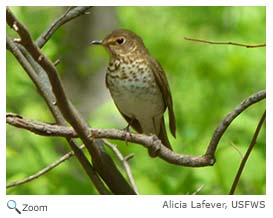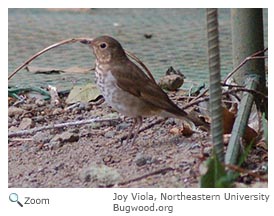Veery - Catharus fuscescens |
|||||||||||
Description
It has a clear and recognizable song that is particularly easy to hear cascading through the woods during breeding season. RangeThe veery is migratory and has a very large range. During breeding season, it lives along the border between Canada and the United States from British Columbia to Maine and Nova Scotia. From southern Canada, the veery's range dips south into the Rocky Mountains, along the Great Lakes, along the Appalacian Mountains and throughout New England. In the fall, the veery migrates to central and southern Brazil. HabitatThe veery spends the summer in spots along rivers in damp, deciduous forests. Distrurbed forests with a dense understory are preferred. |
Diet
Life CycleThe veery forms a cup shaped nest on the ground at the base of a small tree. The nest is made of dead leaves, bark from grapevine, weeds and decomposing leaves. The veery lines the nest with fine roots and fibers. In the nest, the female lays 1-5 pale, greenish blue eggs. Upon hatching, the young chicks are helpless, have few feathers and need to be cared for by the parents. BehaviorThe veery can fly up to 160 miles in one night. It can also fly at altitudes above 2,000 feet. That is1.2 miles above the ground! |
||||||||||
Audio Credit: xeno-canto.org Mike Nelson |
|||||||||||


